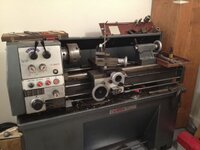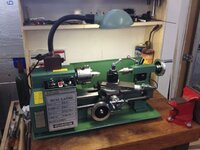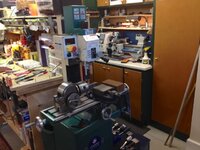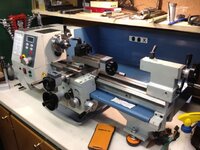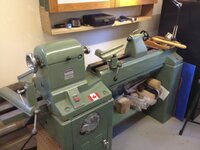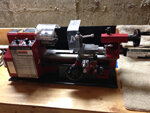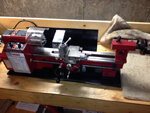RogerBean
Member
First the disclaimer: I am not a lathe expert, and am certainly not a master machinist, so this isn't intended to be a comprehensive review. It is only a description of my experience over the past three decades as an on and off hobby machinist whose interests have shifted several times, leaving me with several different machines. I speak here with particular emphasis on pen making.
About thirty years ago I bought a 12 x 36 Cheves brand (also sold as Center brand) geared head precision toolroom lathe, primarily for gun work. As a first lathe, I had a lot of optimism and precious little skill. At about 1200 lb with the stand, it is pretty big. But after a while I got to where I could do some useful work. I still like this lathe, and have no great urge to get rid of it, but I hardly use it any more, and not at all for pen work.

For chambering and threading the barrel of a 45-70, it is just the tool. For pens, not so much. Yes, it would work, and I'm sure some guys make fine pens on big lathes, but it doesn't feel like the right tool for me.
I was fortunate to spend two summer visits with Andrew Crawford, the extraordinary English box maker. He says that one big key to making wonderful boxes, is "to learn to work in small scale." i.e. the right size and type of tools, jigs, and fixtures. Boxes are simply different from furniture, carpentry, and cabinet making. You have to learn to think small. I think a similar logic applies to pen making.
About 12 years ago I bought a 7 x 10 mini-lathe from Harbor Freight for the primary purpose of fitting the ferrule ends to bamboo fly rods. I also used it for a few little metal parts, and I made about 30 kit pens with it. It has worked perfectly all this time, without any problems at all. When I got the urge recently to try my hand at custom kit-less fountain pens, this fine little machine had two annoying drawbacks. First, the distance center to center is a bit short to be convenient when drilling. The drill chuck and jobber length drill take up a lot of the available space. Second, the lack of a cam lock tailstock made it necessary to grab the wrench each time the tailstock is moved, which is often.

These little lathes have sold in great quantities over the past 15 years or so. There are many fine websites devoted to their operation, service and upgrades. They are fine little machines, in skilled hands capable of extraordinary work. I still have great affection for this reliable little machine but, well, it's still not ideal for pen work because of the short bed.
After making a couple custom fountain pens on the mini, I found I wanted something a bit bigger, and planned to sell the mini-lathe. However, I really like the little guy. I have since found that having a second little lathe is really handy. With a three jaw chuck fitted it saves me the trouble of changing over from the collet chuck on the SC-4. Hence, I have decided to keep, and even improve, the little mini-lathe. It now has a QC toolpost, a cam-lock tailstock upgrade, and the hand wheels and knobs have been upgraded to metal. It also has a collet chuck. But, it's still a bit small.
My pen machining space is just a tight corner of my garage shop. It's tight, but I rather like it that way. My wood working equipment shares the same garage with my pen making gear, but with a good dust collection system it doesn't cause much concern.

This brings me to my latest purchase, purchased specifically for pen making. This is the 8.5 x 16 "Hi-Torque" lathe from Little Machine Shop. This is really a Sieg SC-4, designed as a mill/lathe combination, though I do not have the optional little milling machine attachment. (I chose, instead, to add a Grizzly G0704 mill for small work.) Some may find the combination machine preferable, though.
After using the small mini-lathe, I wanted something just a bit bigger. I looked around a lot, and the SC-4 popped up. I had been doing business with the LMS for a while and liked their store, and here was a bigger lathe. Let it be known, lathes are a little bit like children: the first cost is only the beginning.
From the outside, my first impression of the SC-4 was that it was well packaged, and arrived undamaged. To my delight, it was only lightly oiled, not covered in that nasty, hard to remove red packing grease. Once out of the carton, and on the bench, you notice that the fit and finish is better than most machines, and the colors a bit more pleasant than many. All adjustments were right on the money, as set at the factory. And, at 204 lb. it's nearly two and a half times as heavy as a mini-lathe. It's very beefy for it's size.

As you can see in the picture, I added a set of Enco adjustable leveling mounts to make it easy to keep the machine in proper level.
For those who are interested there is a great review of the SC-4 at Review: Sieg C4 Lathe . There are also good instruction manuals which can be downloaded at Little Machine Shop, and at Travers Tool online. Also a couple helpful videos on You Tube. (Just search Sieg SC4.)
On balance, I've been very happy with the SC-4. Here are the key things I like:
The 16" bed length - perfect for pens.
The cam-lock tailstock
The variable speed DC motor. Plenty of torque, and instant/stop/reverse.
Size at 204 lb. it has some heft
Precision: well made and finished
The power feed lever, in addition to the half nut lever
(and, it's not ththat ugly Sieg red)
Good manual: From Little Machine Shop (another good one from Travers Tool)
Threading on the SC-4 is a bit different than most of us are used to. It requires use of the "complete reversal method", wherein the leadscrew is not disengaged during the threading process. Hence, there is no threading gage to tell you when to re-engage the lead-screw. This method is discussed at some length in Harold Hall's superb book "Threading in the Lathe", No. 34 in the Workshop Practice Series (Amazon used for $7).
I've not cut any single point threads with this lathe yet, as I've been using taps and dies so far. But, I'll be able to give a report of how it works soon, as I plan a couple piston feed pens which will require cutting some very fine (.5m) threads on the inside of the barrel to hold the piston mechanism.
Also, I'll be cutting the triple lead inside and outside threads with the lathe as well. The real advantage here is that one can cut the threads on any diameter body required by the siize of the pen, and not be strictly limited to the 10,12, and 14mm 3 start taps and dies currently available, not to mention the $400 or so for the complete set.
I now have all the necessary tooling and am presently gearing up for this project, so I'll have to post an update after I get deeper into it.
The LMS ER-32 collet chuck for the SC-4 (and the mini-lathe) permits through-chucking of a 10" long round blank, and works well. It's on my lathe almost all the time. I also plan to use it to register the start points for the 3 start cap threads, just by leaving the workpiece clamped in tight and rotating the chuck through the three threaded mounting holes in the chuck to spindle mount. I think this will work fine to register the workpiece for each of the threading passes and seems to be the simplest of several alternatives.
I plan to cut these threads under manual power. One could engage the power feed, but that's pressing my skill a little at this stage. But, at slow speed there's no reason why a better man than me couldn't use power for most small threading operations. The SC-4 has a virtually instant stop/reverse feature courtesy of the DC variable speed motor. This is handy for threading with dies as well, even if you choose to feed in by hand, you can reverse out easily using the reverse button. (And avoid repeatedly banging my hand on the cutting tool. Ouch)
The cam-lock tailstock is solid and convenient. The tailstock spindle is calibrated in one mm increments out to 40 mm which is nice for gauging depth of drilled holes where extreme accuracy is not required. You can get to 1/4mm (about .010) accuracy with just the tailstock. Longer than 40mm and you still have to mark the bit. I find the graduated tailstock very convenient, over my mini-lathe. As I mentioned above, I upgraded my mini-lathe to include the cam-lock tailstock as well.
A quick note on drill chucks. The mini and the SC-4 both take a MT-2 tailstock arbor, but the mini needs a short arbor, and while the short one will work on the SC-4 it will not eject, and beating it off with a wood mallet is not a great idea if you do it too many times.
The optional OXA QC toolpost is a really nice option I would really hate to give up. I have now them to both the SC-4 and the mini. And as they use the same tool holders, I can move tools from one machine to the other quickly and easily, without shimming, or disassembling the tool holders. Being lazy, I like that.
The SC-4 has ample power for a small machine. The power feed, in addition to the lead screw engagement lever makes it easy to take a quick roughing cut then a smooth finishing cut without changing any gears. Handy.
I ordered a 1" lathe dog so I could turn square pen blanks to round, and added several small boring bars. The lathe dog drive stud screws right into the spindle flange, and a pair of dead centers come with the lathe. Handy for turning down those 10" square pen blanks to round so I can use the collet chuck.
I added the digital positioning readouts from LMS. While these are not "true" DRO's in so far as they only measure knob rotation, not actual position, they work fine as all movement is in one direction and claim to be accurate to .001, and repeatable to .0005 and read in inch and metric. They apply to the compound and cross slides only. Not the longitudinal carriage position. But you can get longitudinal measurement by placing the compound parallel to the ways ...certainly enough for most pen work. I only recently installed it, but so far it seems to work well. Nice to just zero the readout and not have to try to remember the hand wheel positions.
The SC-4 will cut virtually any thread you might need, has all metal change-gearing, and it can cut left or right hand NC or Metric threads. For example, if you are using a piston feed, you need to be able to cut single point threads in odd sizes like 9.4m x .5 in both right and left hand. Plus, cutting triple start threads for the cap/barrel threads.
Other lathes can work as well as this one. A lot of folks have 9 x 20's and do great work with them. No argument from me. Those who advocate the CNC approach with lathes like the Emco Compact 5, will be advocates of their individual choice. No argument from me. These are good choices as well. I have chosen to not go the CNC route, but certainly have nothing against that choice.
I'm not oblivious to the merits of the wood lathe either. It's certainly possible to work much more quickly on a wood lathe. My wood lathe though is a bit like my big metal lathe... big. It's a General 260; it's a wonderful, heavy, and rock-solid machine, and I like it a lot for turned boxes and furniture work.

I also use it to drive a couple buffing arbors, placed in the Stronghold chuck. It's a tolerable substitute for a dedicated buffer.
I've turned a couple pens on it, but it seems a bit like driving an Abrams tank to the corner store to get a quart of milk. Works, surely, but a bit much. And I don't have a small wood lathe. Plus, I generally prefer the precision of the metal lathe. I also prefer straight sided pens for the most part, and if I need to create curves, I can do it relatively easily in the metal lathe with a makeshift tool post to hold a regular lathe chisel, or shape with a small file. (The method I've come to prefer for shaping sections.)
I've noticed a lot of folks leaning toward the Micro-Lux 7 x 16. I looked hard at that lathe, and found much to recommend it, even though I finally decided to go with the LMS 8.5 x 16. I have no reason to think it's not a great choice, and it does save some money. LMS also has a 7 x 12 which is worth a look as well; it actually has about four more inches usable bed than my little 7 x 10.
I've found the folks at LMS to really helpful, and their speed and service to be above reproach. Chris Wood seems willing to answer any trivial question I may have.
I'm certainly not saying my choices are right for everyone. My purpose is only to add a little information, and if someone finds it helpful, great. I certainly don't consider myself a master machinist; just a guy who likes to make a few pens. There are folks on this forum who are vastly more experienced and skillful with a metal lathe than I am. I just hope these thoughts are useful to any folks who are struggling with the same purchase decisions I have. In the end, I don't think there is any "right" answer, just different trade-offs.
About thirty years ago I bought a 12 x 36 Cheves brand (also sold as Center brand) geared head precision toolroom lathe, primarily for gun work. As a first lathe, I had a lot of optimism and precious little skill. At about 1200 lb with the stand, it is pretty big. But after a while I got to where I could do some useful work. I still like this lathe, and have no great urge to get rid of it, but I hardly use it any more, and not at all for pen work.
For chambering and threading the barrel of a 45-70, it is just the tool. For pens, not so much. Yes, it would work, and I'm sure some guys make fine pens on big lathes, but it doesn't feel like the right tool for me.
I was fortunate to spend two summer visits with Andrew Crawford, the extraordinary English box maker. He says that one big key to making wonderful boxes, is "to learn to work in small scale." i.e. the right size and type of tools, jigs, and fixtures. Boxes are simply different from furniture, carpentry, and cabinet making. You have to learn to think small. I think a similar logic applies to pen making.
About 12 years ago I bought a 7 x 10 mini-lathe from Harbor Freight for the primary purpose of fitting the ferrule ends to bamboo fly rods. I also used it for a few little metal parts, and I made about 30 kit pens with it. It has worked perfectly all this time, without any problems at all. When I got the urge recently to try my hand at custom kit-less fountain pens, this fine little machine had two annoying drawbacks. First, the distance center to center is a bit short to be convenient when drilling. The drill chuck and jobber length drill take up a lot of the available space. Second, the lack of a cam lock tailstock made it necessary to grab the wrench each time the tailstock is moved, which is often.
These little lathes have sold in great quantities over the past 15 years or so. There are many fine websites devoted to their operation, service and upgrades. They are fine little machines, in skilled hands capable of extraordinary work. I still have great affection for this reliable little machine but, well, it's still not ideal for pen work because of the short bed.
After making a couple custom fountain pens on the mini, I found I wanted something a bit bigger, and planned to sell the mini-lathe. However, I really like the little guy. I have since found that having a second little lathe is really handy. With a three jaw chuck fitted it saves me the trouble of changing over from the collet chuck on the SC-4. Hence, I have decided to keep, and even improve, the little mini-lathe. It now has a QC toolpost, a cam-lock tailstock upgrade, and the hand wheels and knobs have been upgraded to metal. It also has a collet chuck. But, it's still a bit small.
My pen machining space is just a tight corner of my garage shop. It's tight, but I rather like it that way. My wood working equipment shares the same garage with my pen making gear, but with a good dust collection system it doesn't cause much concern.
This brings me to my latest purchase, purchased specifically for pen making. This is the 8.5 x 16 "Hi-Torque" lathe from Little Machine Shop. This is really a Sieg SC-4, designed as a mill/lathe combination, though I do not have the optional little milling machine attachment. (I chose, instead, to add a Grizzly G0704 mill for small work.) Some may find the combination machine preferable, though.
After using the small mini-lathe, I wanted something just a bit bigger. I looked around a lot, and the SC-4 popped up. I had been doing business with the LMS for a while and liked their store, and here was a bigger lathe. Let it be known, lathes are a little bit like children: the first cost is only the beginning.
From the outside, my first impression of the SC-4 was that it was well packaged, and arrived undamaged. To my delight, it was only lightly oiled, not covered in that nasty, hard to remove red packing grease. Once out of the carton, and on the bench, you notice that the fit and finish is better than most machines, and the colors a bit more pleasant than many. All adjustments were right on the money, as set at the factory. And, at 204 lb. it's nearly two and a half times as heavy as a mini-lathe. It's very beefy for it's size.
As you can see in the picture, I added a set of Enco adjustable leveling mounts to make it easy to keep the machine in proper level.
For those who are interested there is a great review of the SC-4 at Review: Sieg C4 Lathe . There are also good instruction manuals which can be downloaded at Little Machine Shop, and at Travers Tool online. Also a couple helpful videos on You Tube. (Just search Sieg SC4.)
On balance, I've been very happy with the SC-4. Here are the key things I like:
The 16" bed length - perfect for pens.
The cam-lock tailstock
The variable speed DC motor. Plenty of torque, and instant/stop/reverse.
Size at 204 lb. it has some heft
Precision: well made and finished
The power feed lever, in addition to the half nut lever
(and, it's not ththat ugly Sieg red)
Good manual: From Little Machine Shop (another good one from Travers Tool)
Threading on the SC-4 is a bit different than most of us are used to. It requires use of the "complete reversal method", wherein the leadscrew is not disengaged during the threading process. Hence, there is no threading gage to tell you when to re-engage the lead-screw. This method is discussed at some length in Harold Hall's superb book "Threading in the Lathe", No. 34 in the Workshop Practice Series (Amazon used for $7).
I've not cut any single point threads with this lathe yet, as I've been using taps and dies so far. But, I'll be able to give a report of how it works soon, as I plan a couple piston feed pens which will require cutting some very fine (.5m) threads on the inside of the barrel to hold the piston mechanism.
Also, I'll be cutting the triple lead inside and outside threads with the lathe as well. The real advantage here is that one can cut the threads on any diameter body required by the siize of the pen, and not be strictly limited to the 10,12, and 14mm 3 start taps and dies currently available, not to mention the $400 or so for the complete set.
I now have all the necessary tooling and am presently gearing up for this project, so I'll have to post an update after I get deeper into it.
The LMS ER-32 collet chuck for the SC-4 (and the mini-lathe) permits through-chucking of a 10" long round blank, and works well. It's on my lathe almost all the time. I also plan to use it to register the start points for the 3 start cap threads, just by leaving the workpiece clamped in tight and rotating the chuck through the three threaded mounting holes in the chuck to spindle mount. I think this will work fine to register the workpiece for each of the threading passes and seems to be the simplest of several alternatives.
I plan to cut these threads under manual power. One could engage the power feed, but that's pressing my skill a little at this stage. But, at slow speed there's no reason why a better man than me couldn't use power for most small threading operations. The SC-4 has a virtually instant stop/reverse feature courtesy of the DC variable speed motor. This is handy for threading with dies as well, even if you choose to feed in by hand, you can reverse out easily using the reverse button. (And avoid repeatedly banging my hand on the cutting tool. Ouch)
The cam-lock tailstock is solid and convenient. The tailstock spindle is calibrated in one mm increments out to 40 mm which is nice for gauging depth of drilled holes where extreme accuracy is not required. You can get to 1/4mm (about .010) accuracy with just the tailstock. Longer than 40mm and you still have to mark the bit. I find the graduated tailstock very convenient, over my mini-lathe. As I mentioned above, I upgraded my mini-lathe to include the cam-lock tailstock as well.
A quick note on drill chucks. The mini and the SC-4 both take a MT-2 tailstock arbor, but the mini needs a short arbor, and while the short one will work on the SC-4 it will not eject, and beating it off with a wood mallet is not a great idea if you do it too many times.
The optional OXA QC toolpost is a really nice option I would really hate to give up. I have now them to both the SC-4 and the mini. And as they use the same tool holders, I can move tools from one machine to the other quickly and easily, without shimming, or disassembling the tool holders. Being lazy, I like that.
The SC-4 has ample power for a small machine. The power feed, in addition to the lead screw engagement lever makes it easy to take a quick roughing cut then a smooth finishing cut without changing any gears. Handy.
I ordered a 1" lathe dog so I could turn square pen blanks to round, and added several small boring bars. The lathe dog drive stud screws right into the spindle flange, and a pair of dead centers come with the lathe. Handy for turning down those 10" square pen blanks to round so I can use the collet chuck.
I added the digital positioning readouts from LMS. While these are not "true" DRO's in so far as they only measure knob rotation, not actual position, they work fine as all movement is in one direction and claim to be accurate to .001, and repeatable to .0005 and read in inch and metric. They apply to the compound and cross slides only. Not the longitudinal carriage position. But you can get longitudinal measurement by placing the compound parallel to the ways ...certainly enough for most pen work. I only recently installed it, but so far it seems to work well. Nice to just zero the readout and not have to try to remember the hand wheel positions.
The SC-4 will cut virtually any thread you might need, has all metal change-gearing, and it can cut left or right hand NC or Metric threads. For example, if you are using a piston feed, you need to be able to cut single point threads in odd sizes like 9.4m x .5 in both right and left hand. Plus, cutting triple start threads for the cap/barrel threads.
Other lathes can work as well as this one. A lot of folks have 9 x 20's and do great work with them. No argument from me. Those who advocate the CNC approach with lathes like the Emco Compact 5, will be advocates of their individual choice. No argument from me. These are good choices as well. I have chosen to not go the CNC route, but certainly have nothing against that choice.
I'm not oblivious to the merits of the wood lathe either. It's certainly possible to work much more quickly on a wood lathe. My wood lathe though is a bit like my big metal lathe... big. It's a General 260; it's a wonderful, heavy, and rock-solid machine, and I like it a lot for turned boxes and furniture work.
I also use it to drive a couple buffing arbors, placed in the Stronghold chuck. It's a tolerable substitute for a dedicated buffer.
I've turned a couple pens on it, but it seems a bit like driving an Abrams tank to the corner store to get a quart of milk. Works, surely, but a bit much. And I don't have a small wood lathe. Plus, I generally prefer the precision of the metal lathe. I also prefer straight sided pens for the most part, and if I need to create curves, I can do it relatively easily in the metal lathe with a makeshift tool post to hold a regular lathe chisel, or shape with a small file. (The method I've come to prefer for shaping sections.)
I've noticed a lot of folks leaning toward the Micro-Lux 7 x 16. I looked hard at that lathe, and found much to recommend it, even though I finally decided to go with the LMS 8.5 x 16. I have no reason to think it's not a great choice, and it does save some money. LMS also has a 7 x 12 which is worth a look as well; it actually has about four more inches usable bed than my little 7 x 10.
I've found the folks at LMS to really helpful, and their speed and service to be above reproach. Chris Wood seems willing to answer any trivial question I may have.
I'm certainly not saying my choices are right for everyone. My purpose is only to add a little information, and if someone finds it helpful, great. I certainly don't consider myself a master machinist; just a guy who likes to make a few pens. There are folks on this forum who are vastly more experienced and skillful with a metal lathe than I am. I just hope these thoughts are useful to any folks who are struggling with the same purchase decisions I have. In the end, I don't think there is any "right" answer, just different trade-offs.

